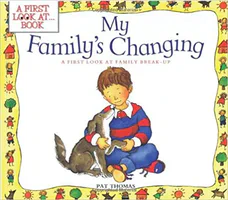My Family’s Changing
A first look at family break-up

Recommended Age Range: Preschool through 1st grade.
Publisher's Summary:
“This helpful picture book explores the issue of divorce in reassuringly simple terms. Children’s fears, worries, and questions about this difficult experience are made accessible and approachable. This book will help promote interaction among children, parents and teachers on an issue that affects many families.”

Dr. Annie's Takeaways
Recommended for: This book provides a developmentally appropriate explanation of what divorce is and how it might impact a child. The book is fairly dry but useful; parents may even choose to read this on their own and borrow the language when talking with their children.
Would a child like it? It’s definitely not a fun book. There’s no plot, and it’s not entertaining. But I think parents would likely find it useful as a way to scaffold important conversations with their child.
Tone: Matter-of-fact, informational
Story Quality: This is an informational book about divorce. The author speaks directly to the child being read to in order to inform them about divorce and prepare them for the changes to come–e.g., “Something is happening in your family. It is called divorce and you are all going through it together.” The descriptions are clear and normalizing.
Illustrations: Simple cartoon-like drawings
Representation: The family pictured in the illustrations is White, and the home depicted appears to be in a suburban environment. There is a page that states that the parents who are getting divorced “made a baby together. And that baby was you,” which isn’t true for all parents and children. The parents depicted in the illustrations appear to be a heterosexual couple, although this is never specified in the text (it’s always just “your parents”). On the pages talking about a parent who does not have custody, the illustrations depict a father. There are some Black and Brown children depicted in a page about friends, as well as in “child-drawn” illustrations next to the discussion prompts. A woman of color is depicted as an attorney.
Psychological Practices: This book is a good reminder to parents that children often do not understand what divorce is or what it will mean for them and their family, and it provides developmentally appropriate language to explain these things (e.g., it clarifies that divorce is usually forever and that it isn’t ever the child’s fault.) It normalizes different custody arrangements and doesn’t over-promise (e.g., “Sometimes [your parents] are happier than before, sometimes they are sadder”). The discussion questions are useful for initiating important conversations between parents and children (e.g., “When these changes are happening in a family, many children might feel sad or scared or angry or confused. How do you feel?”).
Concerns: There’s a page that says, “Sometimes parents say bad things about the other parent or buy lots of presents to make you love them more. You may want to tell them not to do this and remind them that you enjoy being with each of them.” I think this page is in the book as instruction for parents rather than kids, but it’s not a child’s role to tell their parents to stop doing these things.
